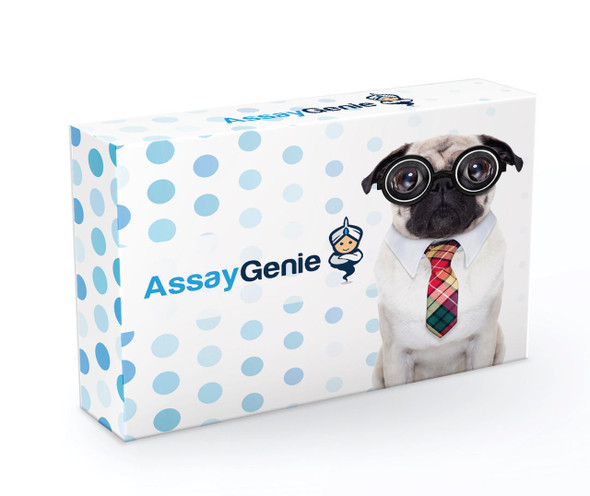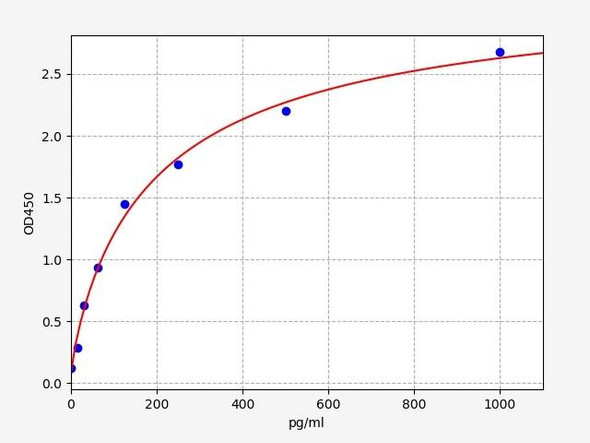Human Cell Biology ELISA Kits 5
Human EMMPRIN/CD147 (Extracellular Matrix Metalloproteinase Inducer) CLIA Kit (HUES00916)
- SKU:
- HUES00916
- Product Type:
- ELISA Kit
- ELISA Type:
- CLIA Kit
- Size:
- 96 Assays
- Sensitivity:
- 7.5pg/mL
- Range:
- 12.5-800pg/mL
- ELISA Type:
- Sandwich
- Reactivity:
- Human
- Sample Type:
- Serum, plasma and other biological fluids
- Research Area:
- Cell Biology
Description
| Assay type: | Sandwich |
| Format: | 96T |
| Assay time: | 4.5h |
| Reactivity: | Human |
| Detection method: | Chemiluminescence |
| Detection range: | 12.50-800 pg/mL |
| Sensitivity: | 7.50 pg/mL |
| Sample volume: | 100µL |
| Sample type: | Serum, plasma and other biological fluids |
| Repeatability: | CV < 15% |
| Specificity: | This kit recognizes Human EMMPRIN/CD147 in samples. No significant cross-reactivity or interference between Human EMMPRIN/CD147 and analogues was observed. |
This kit uses Sandwich-CLIA as the method. The micro CLIA plate provided in this kit has been pre-coated with an antibody specific to Human EMMPRIN/CD147. Standards or samples are added to the appropriate micro CLIA plate wells and combined with the specific antibody. Then a biotinylated detection antibody specific for Human EMMPRIN/CD147 and Avidin-Horseradish Peroxidase (HRP) conjugate are added to each micro plate well successively and incubated. Free components are washed away. The substrate solution is added to each well. Only those wells that contain Human EMMPRIN/CD147, biotinylated detection antibody and Avidin-HRP conjugate will appear fluorescence. The Relative light unit (RLU) value is measured spectrophotometrically by the Chemiluminescence immunoassay analyzer. The RLU value is positively associated with the concentration of Human EMMPRIN/CD147. The concentration of Human EMMPRIN/CD147 in the samples can be calculated by comparing the RLU of the samples to the standard curve.
| UniProt Protein Function: | BSG: Plays pivotal roles in spermatogenesis, embryo implantation, neural network formation and tumor progression. Stimulates adjacent fibroblasts to produce matrix metalloproteinases (MMPS). May target monocarboxylate transporters SLC16A1, SLC16A3 and SLC16A8 to plasma membranes of retinal pigment epithelium and neural retina. Seems to be a receptor for oligomannosidic glycans. In vitro, promotes outgrowth of astrocytic processes. Enriched on the surface of tumor cells. Up-regulated in gliomas. Its expression levels correlate with malignant potential of the tumor. Forms homooligomers in a cis-dependent manner on the plasma membrane. Forms a complex with MMP1 at the tumor cell surface. Interacts with SLC16A1 and SLC1A3; probably a BSG dimer is associated with a monocarboxylate transporter dimer. Interacts with ATP1B2, MAG and L1CAM. Interacts with AJAP1. 2 isoforms of the human protein are produced by alternative splicing. |
| UniProt Protein Details: | Protein type:Membrane protein, integral; Immunoglobulin superfamily Chromosomal Location of Human Ortholog: 19p13. 3 Cellular Component: acrosomal membrane; focal adhesion; Golgi membrane; integral to plasma membrane; lipid raft; melanosome; membrane; mitochondrion; plasma membrane; sarcolemma Molecular Function:mannose binding; protein binding Biological Process: blood coagulation; cell surface receptor linked signal transduction; cellular metabolic process; decidualization; embryo implantation; extracellular matrix disassembly; extracellular matrix organization and biogenesis; leukocyte migration; odontogenesis of dentine-containing teeth; pyruvate metabolic process; response to cAMP; response to mercury ion; response to peptide hormone stimulus Disease: Blood Group--ok |
| NCBI Summary: | The protein encoded by this gene is a plasma membrane protein that is important in spermatogenesis, embryo implantation, neural network formation, and tumor progression. The encoded protein is also a member of the immunoglobulin superfamily. Multiple transcript variants encoding different isoforms have been found for this gene. [provided by RefSeq, Jul 2008] |
| UniProt Code: | P35613 |
| NCBI GenInfo Identifier: | 51704273 |
| NCBI Gene ID: | 682 |
| NCBI Accession: | P35613. 2 |
| UniProt Secondary Accession: | P35613,Q7Z796, Q8IZL7, A6NJW1, D3YLG5, |
| UniProt Related Accession: | P35613 |
| Molecular Weight: | 22,764 Da |
| NCBI Full Name: | Basigin |
| NCBI Synonym Full Names: | basigin (Ok blood group) |
| NCBI Official Symbol: | BSG |
| NCBI Official Synonym Symbols: | OK; 5F7; TCSF; CD147; EMMPRIN |
| NCBI Protein Information: | basigin |
| UniProt Protein Name: | Basigin |
| UniProt Synonym Protein Names: | 5F7; Collagenase stimulatory factor; Extracellular matrix metalloproteinase inducer; EMMPRIN; Leukocyte activation antigen M6; OK blood group antigen; Tumor cell-derived collagenase stimulatory factor; TCSF; CD_antigen: CD147 |
| Protein Family: | Basigin |
| UniProt Gene Name: | BSG |
| UniProt Entry Name: | BASI_HUMAN |
As the RLU values of the standard curve may vary according to the conditions of the actual assay performance (e. g. operator, pipetting technique, washing technique or temperature effects), the operator should establish a standard curve for each test. Typical standard curve and data is provided below for reference only.
| Concentration (pg/mL) | RLU | Average | Corrected |
| 800 | 48465 56819 | 52642 | 52616 |
| 400 | 20627 22841 | 21734 | 21708 |
| 200 | 10174 9242 | 9708 | 9682 |
| 100 | 4204 4900 | 4552 | 4526 |
| 50 | 2246 2130 | 2188 | 2162 |
| 25 | 1119 1001 | 1060 | 1034 |
| 12.50 | 488 530 | 509 | 483 |
| 0 | 25 27 | 26 | -- |
Precision
Intra-assay Precision (Precision within an assay): 3 samples with low, mid range and high level Human EMMPRIN/CD147 were tested 20 times on one plate, respectively.
Inter-assay Precision (Precision between assays): 3 samples with low, mid range and high level Human EMMPRIN/CD147 were tested on 3 different plates, 20 replicates in each plate.
| Intra-assay Precision | Inter-assay Precision | |||||
| Sample | 1 | 2 | 3 | 1 | 2 | 3 |
| n | 20 | 20 | 20 | 20 | 20 | 20 |
| Mean (pg/mL) | 41.16 | 104.07 | 294.21 | 43.41 | 106.21 | 306.05 |
| Standard deviation | 4.73 | 8.94 | 26.98 | 5.53 | 7.54 | 21.85 |
| C V (%) | 11.49 | 8.59 | 9.17 | 12.74 | 7.10 | 7.14 |
Recovery
The recovery of Human EMMPRIN/CD147 spiked at three different levels in samples throughout the range of the assay was evaluated in various matrices.
| Sample Type | Range (%) | Average Recovery (%) |
| Serum (n=5) | 92-103 | 98 |
| EDTA plasma (n=5) | 94-112 | 102 |
| Cell culture media (n=5) | 98-112 | 103 |
Linearity
Samples were spiked with high concentrations of Human EMMPRIN/CD147 and diluted with Reference Standard & Sample Diluent to produce samples with values within the range of the assay.
| Serum (n=5) | EDTA plasma (n=5) | Cell culture media (n=5) | ||
| 1:2 | Range (%) | 103-120 | 100-117 | 87-100 |
| Average (%) | 110 | 107 | 93 | |
| 1:4 | Range (%) | 97-113 | 101-116 | 85-99 |
| Average (%) | 104 | 107 | 91 | |
| 1:8 | Range (%) | 95-107 | 87-101 | 99-113 |
| Average (%) | 100 | 93 | 106 | |
| 1:16 | Range (%) | 99-112 | 93-108 | 99-114 |
| Average (%) | 105 | 100 | 105 |
An unopened kit can be stored at 4°C for 1 month. If the kit is not used within 1 month, store the items separately according to the following conditions once the kit is received.
| Item | Specifications | Storage |
| Micro CLIA Plate(Dismountable) | 8 wells ×12 strips | -20°C, 6 months |
| Reference Standard | 2 vials | |
| Concentrated Biotinylated Detection Ab (100×) | 1 vial, 120 µL | |
| Concentrated HRP Conjugate (100×) | 1 vial, 120 µL | -20°C(shading light), 6 months |
| Reference Standard & Sample Diluent | 1 vial, 20 mL | 4°C, 6 months |
| Biotinylated Detection Ab Diluent | 1 vial, 14 mL | |
| HRP Conjugate Diluent | 1 vial, 14 mL | |
| Concentrated Wash Buffer (25×) | 1 vial, 30 mL | |
| Substrate Reagent A | 1 vial, 5 mL | 4°C (shading light) |
| Substrate Reagent B | 1 vial, 5 mL | 4°C (shading light) |
| Plate Sealer | 5 pieces | |
| Product Description | 1 copy | |
| Certificate of Analysis | 1 copy |
- Set standard, test sample and control (zero) wells on the pre-coated plate and record theirpositions. It is recommended to measure each standard and sample in duplicate. Note: addall solutions to the bottom of the plate wells while avoiding contact with the well walls. Ensuresolutions do not foam when adding to the wells.
- Aliquot 100 µL of standard solutions into the standard wells.
- Add 100 µL of Sample / Standard dilution buffer into the control (zero) well.
- Add 100 µL of properly diluted sample (serum, plasma, tissue homogenates and otherbiological fluids. ) into test sample wells.
- Cover the plate with the sealer provided in the kit and incubate for 90 min at 37 °C.
- Aspirate the liquid from each well, do not wash. Immediately add 100 µL of BiotinylatedDetection Ab working solution to each well. Cover the plate with a plate seal and gently mix. Incubate for 1 hour at 37 °C.
- Aspirate or decant the solution from the plate and add 350 µL of wash buffer to each welland incubate for 1-2 minutes at room temperature. Aspirate the solution from each well andclap the plate on absorbent filter paper to dry. Repeat this process 3 times. Note: a microplatewasher can be used in this step and other wash steps.
- Add 100 µL of HRP Conjugate working solution to each well. Cover with a plate seal andincubate for 30 min at 37 °C.
- Aspirate or decant the solution from each well. Repeat the wash process for five times asconducted in step 7.
- Add 100 µL of Substrate mixture solution to each well. Cover with a new plate seal andincubate for no more than 5 min at 37 °C. Protect the plate from light.
- Determine the RLU value of each well immediately.






